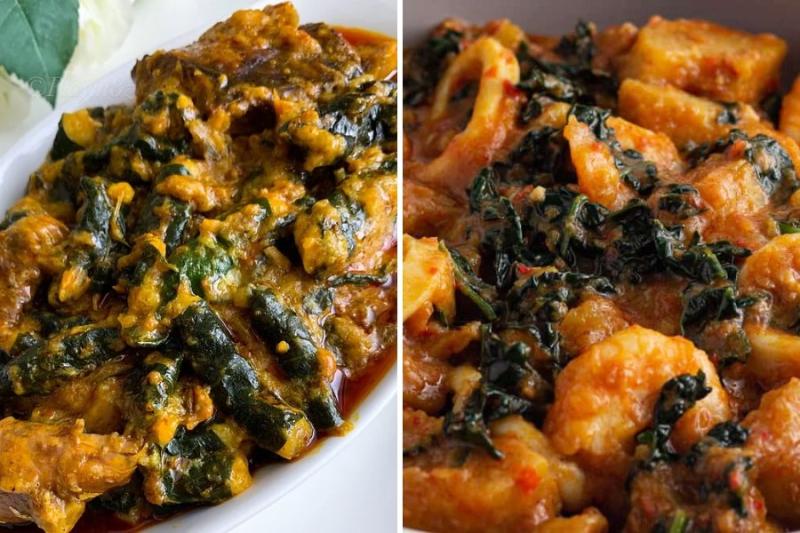It’s not debatable that Ekpangkukwu and plantain porridge are delicious delicacies consumed mainly by West Africans. But what exactly could be the primary difference between these two foods? Could it be the colour, ingredients, method of preparation or even those sets of persons who consume the food? Read on to find out more.
What is Ekpangkukwo?
Ekpangkukwo (also known as Ekpan Nkukwo) is a traditional Nigerian dish popular among the Efik and Ibibio people of Akwa Ibom and Cross River States in the southern part of Nigeria. It is made by wrapping grated cocoyam and water yam (ede in the Yoruba language) in leaves, then cooking it in a special soup made with vegetables, spices, and sometimes, meat or fish. The dish is similar to the well-known Nigerian dish, Edikang Ikong, but instead of using pumpkin leaves (Ugwu) and water leaves, Ekpangkukwo uses cocoyam leaves. Preparing Ekpangkukwo is a labour-intensive process that requires patience and skill, as the cocoyam and water yam must be carefully grated, and the leaves must be properly cleaned and tied. However, the result is a delicious and nutritious dish rich in fibre, vitamins, and minerals. Ekpangkukwo is often served at special occasions and celebrations, such as weddings and festivals, and is enjoyed by many Nigerians as a beloved traditional delicacy.
What is Plantain Porridge?
Plantain porridge is a popular West African dish with ripe or unripe plantains cooked in a flavorful broth. The plantains are usually cut into chunks and simmered with a combination of vegetables, meat or fish, spices, and seasonings. The exact ingredients and preparation method can vary depending on the recipe and the region. Still, some common ingredients used in plantain porridge include tomatoes, onions, garlic, ginger, stock or bouillon cubes, pepper, and palm oil or vegetable oil. Plantain porridge is a hearty and filling meal popular across many West African countries, including Nigeria, Ghana, and Cameroon. It can be served as a main course or a side dish, often accompanied by rice or another starchy food. The dish is also popular among vegans and vegetarians, who may use plant-based meat substitutes or omit the meat altogether. Overall, plantain porridge is a flavorful and satisfying dish that showcases the diverse and delicious cuisine of West Africa.
Difference Between Ekpangkukwo And Plantain Porriage
Ekpangkukwo and Plantain Porridge are both popular traditional dishes in West Africa, but they have distinct differences in their ingredients, preparation methods, and flavours. Ekpangkukwo is a dish specific to the Efik and Ibibio people of Akwa Ibom and Cross River States in Nigeria. It is made with grated cocoyam and water yam wrapped in cocoyam leaves and cooked in a special soup made with vegetables, spices, and sometimes meat or fish. Plantain Porridge, on the other hand, is made with ripe or unripe plantains cut into chunks and cooked in a flavorful broth with a combination of vegetables, meat or fish, spices, and seasonings. While both dishes are starchy and filling, Ekpangkukwo has a unique taste and texture due to the cocoyam and water yam, while Plantain Porridge has a sweeter taste due to the plantains. Ekpangkukwo is also more labour-intensive to prepare than Plantain Porridge because of the process of grating the cocoyam and wrapping the mixture in leaves.
In summary, Ekpangkukwo and Plantain Porridge are delicious and nutritious West African dishes but differ in their ingredients, preparation, and taste.






